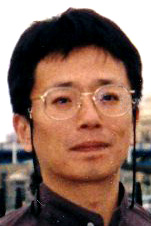
(1963 -2010)
by Pierre-Marie GAGEY

He is 18 years old exactly when he begins his studies of medicine in Matsumoto, this provincial city where living is so nice just down Nihon no Arupuwa. The castle of Matsumoto is always there, standing upright, made of wood, kept in nice conditions to remind to the visitors that Matsumoto held its place in the Japan history. But it is far away the warriors time, fighting became intellectual, the university of Shinshu now reigns on the city.
The leader of the school of Otoneurology, Professor Kiitchiro TAGUCHI came from Kyoto where he had been initiated to the thought of Tadashi FUKUDA (1957) and he really believed that the intuition of the "two phases of the labyrinthine reflex" carried in itself a ferment of revolution of the otoneurological practice: mechanisms of equilibration now could be explored without the conventional technics, ear irrigation with hot or cold water, fast rotation on Barany’s armchair, hard technics that submit the internal ear to rough stimulations. That is why TAGUCHI had been interested very early in stabilometry that permits to observe how man stands upright without hardly stimuling body sensors; Kiitchiro had been one of the pioneers of the frequent analysis of the stabilometric signal (1978).
In Paris, SASAKI was welcomed admirably and helped by a great number of people. At the LENA Lab of the Salpêtrière hospital managed by Bernard RENAULT, Jacques MARTINERIE and Michel LE VAN QUYEN (1999) not only gave him plenty of their time to initiate him to the non linear analysis, but also they gave all their algorithms, what is not a small gift! At the center of functional exploration, rue Falguière, Michel TOUPET and A. L’HÉRITIER allowed him and helped him to record vestibular patients. Finally at the institute of Posturology of Paris, Maurice OUAKNINE gave him the prototype of the AFP40/16 platform, precisely constructed to permit the non linear dynamic analysis of the stabilometric signal. This outstanding collaboration between people from Paris and Marseille to the formation and research of SASAKI allowed him to note that the intuition of TAGUCHI was not deceiving: the non linear dynamic analysis of the stabilometric signal is a marvelous tool in the hands of clinicians posturologists.
Sasaki published three works based on this non linear dynamic analysis.
- Among patients suffering from balance disorders and/or dizziness, the Le Van Quyen index of likeness reveals some aspects that escape conventional analysis of the stabilometric signal, it lets suspect, for example, that the benign positional vertigo doesn't limit itself to a cupulo-lithiase phenomenon (2001).
- Among normal subjects submitted to optokinetic stimulation, this same LVQ index shows modifications of the postural control strategies (2002). This work is very important for clinicians because it gives the proof that the ROMBERG’S QUOTIENT must be calculated not only from the eyes open and closed area. The area, indeed, measures the precision of the stabilization, however one can get the same result by different means. Sasaki gave the proof that subjects could be classified as postural blinds because their area in the eyes open and eyes closed situations were the same, whereas making comparison of the energy they spend in these situations showed that they use more energy to get the same result when they close their eyes. They were not, therefore, insensible to visual informations. It seems that, until now, this information is very badly used... As far as I know, there is no software that calculates Romberg’s quotient from both parameters, area and length. Why?
- Finally in a long prospective survey of patients suffering from Ménières disease, Sasaki shows that the same LVQ index of likeness, and only it, permits to foresee attacks of vertigo, with a good sensitivity and an excellent specificity (2006).
Seeing such a set of success of the non linear dynamic analysis of the stabilometric signal, I am proud of Osamu! All these successes do homage to the sharpness of professor Kiitchiro TAGUCHI intuition that allowed him to feel not only that it was necessary to progress in the analysis of the stabilometric signal because this signal didn't finish to allow us to develop our knowledge of the postural regulation, but again and especially as the non linear parameters would arrange themselves among the "big parameters" of stabilometry. The big parameters, those that straightaway possess of a function of logical operators.
In the history of posturology (and by far other disciplines, besides!.), one notes that when the parameters of mass and acceleration occurred, they had a striking effect, while unblocking the possibility to think the phenomena in a logical context, going until formalization.
The "small stabilometric parameters", that tell the clinicians either it is good or it is bad, are already useful by the picture they give from the phenomenon. But it is obvious they miss the power of the logical operators that introduce the clinician's mind to a certain formalization of what they observe. The Sasaki rhythm, that we owe to Osamu, but also to TAGUCHI, is of those, at least I think so.
Since 2003, doctor SASAKI had been working in the Soujinkai Hospital of Tokyo. Weber and I met him one afternoon of 2006, he explained us that he was overflowed by his clientele, not only he could no longer make research, but also he had no time to practice postural clinical exams.